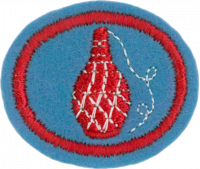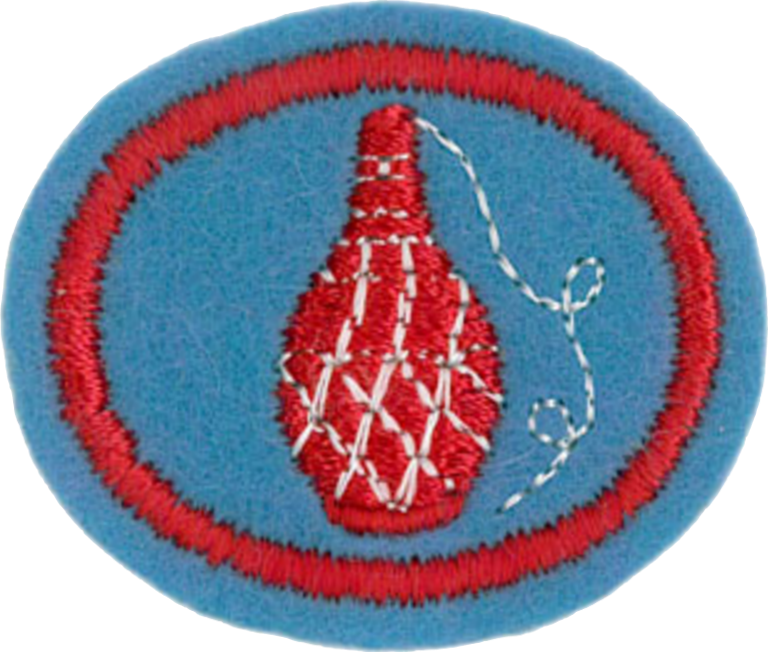Difference between revisions of "AY Honors/Macramé/Answer Key/es"
From Pathfinder Wiki
(Created page with "{{clear}}") |
(Updating to match new version of source page) |
||
| (17 intermediate revisions by 2 users not shown) | |||
| Line 1: | Line 1: | ||
| − | + | {{HonorSubpage}} | |
| − | |||
| − | {{ | ||
| − | |||
| − | |||
| − | |||
| − | |||
| − | |||
| − | |||
| − | |||
| − | }} | ||
| − | |||
| − | |||
<section begin="Body" /> | <section begin="Body" /> | ||
{{ansreq|page={{#titleparts:{{PAGENAME}}|2|1}}|num=1}} | {{ansreq|page={{#titleparts:{{PAGENAME}}|2|1}}|num=1}} | ||
| Line 19: | Line 7: | ||
{{clear}} | {{clear}} | ||
| − | + | {{clear}} | |
| − | + | {{clear}} | |
<noinclude></noinclude> | <noinclude></noinclude> | ||
{{CloseReq}} <!-- 1 --> | {{CloseReq}} <!-- 1 --> | ||
{{ansreq|page={{#titleparts:{{PAGENAME}}|2|1}}|num=2}} | {{ansreq|page={{#titleparts:{{PAGENAME}}|2|1}}|num=2}} | ||
| − | <noinclude></noinclude> | + | <noinclude><div class="mw-translate-fuzzy"> |
| − | <!-- 2. | + | </noinclude> |
| − | + | <!-- 2. ¿Qué es un buen cordón de macramé? --> | |
| + | </div> | ||
<noinclude></noinclude> | <noinclude></noinclude> | ||
| Line 34: | Line 23: | ||
{{ansreq|page={{#titleparts:{{PAGENAME}}|2|1}}|num=3}} | {{ansreq|page={{#titleparts:{{PAGENAME}}|2|1}}|num=3}} | ||
<noinclude></noinclude> | <noinclude></noinclude> | ||
| − | <!-- 3. | + | <!-- 3. Conocer tres tipos de cordones que son buenos y por qué son buenos. --> |
| − | |||
| − | + | {{clear}} | |
| − | |||
| − | |||
| − | |||
<noinclude></noinclude> | <noinclude></noinclude> | ||
{{CloseReq}} <!-- 3 --> | {{CloseReq}} <!-- 3 --> | ||
{{ansreq|page={{#titleparts:{{PAGENAME}}|2|1}}|num=4}} | {{ansreq|page={{#titleparts:{{PAGENAME}}|2|1}}|num=4}} | ||
| − | <noinclude></noinclude> | + | <noinclude><div class="mw-translate-fuzzy"> |
| − | <!-- 4. | + | </noinclude> |
| − | + | <!-- 4. Conocer los nudos básicos utilizados en macramé. Conocer dos variantes de cada uno de estos nudos. --> | |
| + | </div> | ||
| − | {{ | + | {{clear}} |
| − | |||
| − | |||
| − | |||
| − | |||
| − | |||
| − | |||
| − | |||
| − | + | {{clear}} | |
| − | {{ | ||
| − | |||
| − | |||
| − | |||
| − | |||
| − | |||
| − | + | {{clear}} | |
| − | |||
| − | |||
| − | |||
| − | |||
| − | |||
| − | |||
| − | |||
| − | |||
| − | |||
| − | {{ | ||
| − | |||
| − | |||
| − | |||
| − | |||
| − | |||
| − | |||
| − | |||
| − | |||
| − | |||
| − | |||
| − | + | {{clear}} | |
| − | { | ||
| − | |||
| − | |||
| − | |||
| − | |||
| − | |||
| − | |||
| − | |||
| − | |||
| − | |||
| − | |||
| − | + | {{clear}} | |
| − | { | ||
| − | |||
| − | |||
| − | |||
| − | |||
| − | |||
| − | |||
| − | |||
| − | |||
| − | |||
| − | |||
| − | |||
| − | |||
| − | |||
<noinclude></noinclude> | <noinclude></noinclude> | ||
{{CloseReq}} <!-- 4 --> | {{CloseReq}} <!-- 4 --> | ||
{{ansreq|page={{#titleparts:{{PAGENAME}}|2|1}}|num=5}} | {{ansreq|page={{#titleparts:{{PAGENAME}}|2|1}}|num=5}} | ||
| − | <noinclude></noinclude> | + | <noinclude><div class="mw-translate-fuzzy"> |
| − | <!-- 5. | + | </noinclude> |
| − | + | <!-- 5. ¿Cómo es el medio nudo útil en macramé? --> | |
| + | </div> | ||
<noinclude></noinclude> | <noinclude></noinclude> | ||
{{CloseReq}} <!-- 5 --> | {{CloseReq}} <!-- 5 --> | ||
{{ansreq|page={{#titleparts:{{PAGENAME}}|2|1}}|num=6}} | {{ansreq|page={{#titleparts:{{PAGENAME}}|2|1}}|num=6}} | ||
| − | <noinclude></noinclude> | + | <noinclude><div class="mw-translate-fuzzy"> |
| − | <!-- 6. | + | </noinclude> |
| − | + | <!-- 6. ¿Cuánto cordón se necesita para alcanzar la longitud deseada del producto terminado? --> | |
| + | </div> | ||
<noinclude></noinclude> | <noinclude></noinclude> | ||
| Line 135: | Line 65: | ||
{{ansreq|page={{#titleparts:{{PAGENAME}}|2|1}}|num=7}} | {{ansreq|page={{#titleparts:{{PAGENAME}}|2|1}}|num=7}} | ||
<noinclude></noinclude> | <noinclude></noinclude> | ||
| − | <!-- 7. | + | <!-- 7. Hacer una muestra de colgado en la pared utilizando los principales nudos y utilizando al menos dos variantes, tales como el medio cote horizontal, medio cote vertical, o el nudo medio. --> |
| − | + | <div class="mw-translate-fuzzy"> | |
| + | {{clear}} | ||
| + | </div> | ||
<noinclude></noinclude> | <noinclude></noinclude> | ||
{{CloseReq}} <!-- 7 --> | {{CloseReq}} <!-- 7 --> | ||
{{ansreq|page={{#titleparts:{{PAGENAME}}|2|1}}|num=8}} | {{ansreq|page={{#titleparts:{{PAGENAME}}|2|1}}|num=8}} | ||
| − | <noinclude></noinclude> | + | <noinclude><div class="mw-translate-fuzzy"> |
| − | <!-- 8. | + | </noinclude> |
| + | <!-- 8. Hacer otros dos artículos de su elección usando el nudo cuadrado, medio cote doble, y dos variaciones de uno o ambos elementos. --> | ||
| + | </div> | ||
Vea los nudos anteriormente. ¡Diviértase al crear! | Vea los nudos anteriormente. ¡Diviértase al crear! | ||
| Line 153: | Line 87: | ||
<noinclude></noinclude> | <noinclude></noinclude> | ||
| − | + | {{CloseHonorPage}} | |
| − | |||
Latest revision as of 23:21, 13 July 2022
1
Dar una breve historia del arte de nudos decorativos.
2
¿Qué es un buen cordón de macramé?
3
Conocer tres tipos de cordones que son buenos y por qué son buenos.
4
Conocer los nudos básicos utilizados en macramé. Conocer dos variantes de cada uno de estos nudos.
5
¿Cómo es el medio nudo útil en macramé?
6
¿Cuánto cordón se necesita para alcanzar la longitud deseada del producto terminado?
7
Hacer una muestra de colgado en la pared utilizando los principales nudos y utilizando al menos dos variantes, tales como el medio cote horizontal, medio cote vertical, o el nudo medio.
8
Hacer otros dos artículos de su elección usando el nudo cuadrado, medio cote doble, y dos variaciones de uno o ambos elementos.
Vea los nudos anteriormente. ¡Diviértase al crear!


